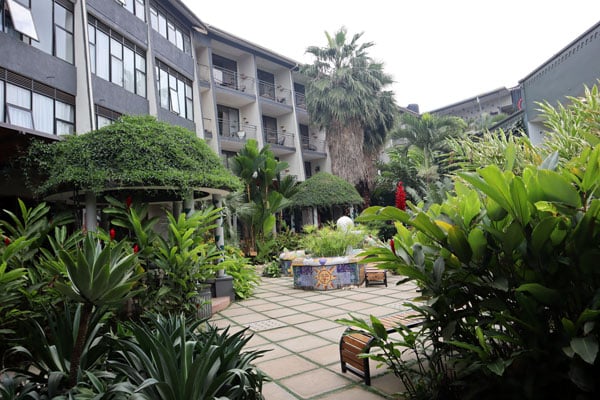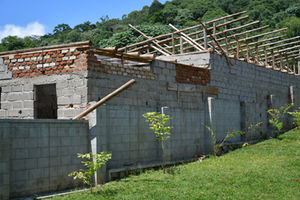
Plants are strategically used to create subtle yet effective divisions, such as the clever use of bamboo to form natural hedges that blend seamlessly into the environment without feeling intrusive. Photos/Tony Mushoborozi.
To truly appreciate the Fairway Hotel and its breathtaking gardens, one must look back to a pivotal moment in 1969. On July 31st of that year, Uganda experienced a historic event; Pope Paul VI’s maiden visit to Uganda. This significant visit was set into motion following the canonisation of the 22 Ugandan martyrs in 1964. The canonisation stirred a deep desire within the Catholic community to honour these saints at their place of sacrifice.
The momentum for the Pope’s visit was furthered during the 1967 Synod of Bishops in Rome, where Archbishop Emmanuel Nsubuga formally extended an invitation to Pope Paul VI. He requested that the Pope visit Uganda and see the site dedicated to the martyrs. This invitation was accepted, and in March 1969, Pope Paul VI announced his intention to visit Uganda.
With the Pope’s visit confirmed, preparations were underway. At the time, Uganda had very few accommodation options, with the Sheraton being the only major hotel. However, the Sheraton was considered too large and impersonal for such a distinguished guest. There was an urgent need for a more intimate and welcoming venue.
Enter Sherali Bandali Jaffer, a wealthy businessman and industrialist who owned a charming, picturesque house in Nakasero, nestled in a lush forest and directly across from the golf course.
Jaffer, who was also a Member of Parliament, was approached by the Catholic Church with a request to host the Pope at his residence. He graciously agreed, providing a more personal and suitable setting for the Pope’s stay. Notably, Bandali Rise, a well-known location in Kampala, was named in his honour.
This act of generosity laid the foundation for what would later become the Fairway Hotel. The property, with its stunning gardens and intimate ambiance, began as a reflection of Jaffer’s hospitable spirit and has since evolved into a celebrated destination, embodying both historical significance and natural beauty.
Hosting the pope
In the months leading up to Pope Paul VI’s historic visit to Uganda, Jaffer embarked on a remarkable transformation of his home. Determined to provide a fitting accommodation for the Pope and his entourage, Jaffer converted his charming residence in Nakasero into a boutique hotel. His home, adjacent to the golf course, was elegantly reimagined to host the esteemed guest.

Following the Pope’s departure, the property, now imbued with a sense of historical significance, drew Catholics eager to experience the blessings associated with the Pope’s visit. To accommodate the growing number of visitors, Jaffer officially transformed his home into a hotel, naming it “Fairway” because, as the family recalls, it seemed as though you were on a golf course amidst the surrounding open spaces.
However, the hotel’s journey took a dramatic turn in 1972 when the then President Idi Amin expelled all Asians from Uganda. As an Asian himself, Jaffer was forced to leave the country, and the once-vibrant Fairway Hotel was left behind. During the 1970s, the Amin government repurposed the property into a military base, a stark contrast to its former role as a refined retreat.
In the 1980s, under the Obote II government, the property was repurposed once again, this time as a hotel training school. It was not until 1990, when the Bandali family regained ownership, that the property was freed from its role as a training facility.
The training school was relocated to Jinja, allowing the Fairway Hotel to reclaim its identity as a premier hotel. The hotel’s renewed prominence was marked by another significant event; the visit of Pope John Paul II in 1993. This second papal visit underscored the Vatican’s continued admiration for the property. In recognition of his contributions, Jaffer was honoured with a medal and three rosaries by the Pope.
Following the second papal visit, Fairway Hotel solidified its reputation as a top-tier establishment in Kampala’s hospitality industry. It became renowned for its exclusivity and charm. However, with the influx of new, upscale hotels around 2007 during the Commonwealth Heads of Government Meeting (CHOGM) in Uganda, Fairway Hotel faced increased competition. Despite this, its legacy as a historic and elegant retreat remains firmly established in Uganda’s hospitality history.
The gardens
To understand why gardens are such an integral part of Fairway Hotel, one must first rewind to the 1920s when Jaffer’s father first built his small cottage. He had travelled from India to Mombasa by dhow in 1890 at the age of 15.
He had walked for six months across the dangerous plains and savannahs of Kenya, entered Uganda, crossed the Nile by canoe and entered the leafy Kingdom of Buganda.
“This was my great-grandfather’s home in the 1920s. It was originally a small house but he kept expanding it to take in orphaned children in his family because life expectancy was very short at the time. By the time my grandfather inherited it, it was a fairly large house.”
“When he built his small home here, in Nakasero, he was utterly in love with the trees and plants that surrounded the house. His son, my grandfather who inherited the property was in love with trees. My grandmother was into plants, my father and my mother were into plants so the garden dates several generations back,” Jaffer says.
New generation, new ideas
While plants have always been a part of Fairway Hotel’s landscape, it is Azhar Bandali Jaffer, the latest generation in the Bandali family, who has truly transformed its gardens into a stunning showcase of horticultural excellence.
Jaffer, who moved from Canada to Uganda in 2010, initially focused on small improvements. However, upon inheriting the hotel in 2018 after his father’s passing, he embarked on a transformative journey to reimagine and enhance the hotel’s green spaces.
Drawing from his extensive travels across more than 40 countries, including experiences in Asia and the Middle East, Jaffer infused the gardens with global design inspirations. His insights, gleaned from online sources such as Pinterest and his personal experiences, were applied with a unique touch to create an environment that promotes privacy and an oasis-like feel.
The transformation extended beyond the hotel’s prominent courtyard, visible to all visitors, to include the backyard, accessible only to residents. This comprehensive approach ensures that every corner of the hotel benefits from lush, thoughtfully curated greenery.
The result is a garden that offers a continuous shade of cool temperatures, thanks to the dense foliage and diverse plant life. The design creates an ambiance of cosiness, privacy, and sophistication; hallmarks of a boutique hotel experience.

For residents, the private sections of the garden such as the pool side offer a sanctuary of peace and relaxation.
Jaffer’s approach involves a layered garden design, a technique that mirrors the natural stratification of a forest. This design incorporates various types of plants, including grasses, vines, shrubs, and trees, arranged in layers. This method not only achieves a dense, forest-like appearance but also ensures that the garden remains vibrant throughout the year. By selecting plants that are well-suited to their specific layers and ensuring that those in the undergrowth thrive despite limited sunlight, Jaffer has crafted a garden that echoes the lush, forested environment of 1920s Kampala.
The layered garden at Fairway Hotel is a testament to Jaffer’s vision and dedication, reflecting a commitment to creating a serene, timeless space that harmonises with its historical surroundings.
Given the Fairway Hotel’s compact size and its location in a bustling area, the thoughtfully designed garden plays a crucial role in ensuring privacy. The lush greenery acts as a natural barrier, effectively separating the hotel’s residential quarters from the conference and dining spaces. Plants are strategically used to create subtle yet effective divisions, such as the clever use of bamboo to form natural hedges that blend seamlessly into the environment without feeling intrusive.
The garden also serves as a visual shield, discreetly partitioning the outdoor restaurant from the swimming pool area. This design ensures that guests can enjoy their meals without being disturbed by the poolside activity, enhancing their overall dining experience.
Maintenance
Azhar Bandali Jaffer says keeping the gardens lush boils down to proper watering, weeding regularly, pruning regularly, applying fertiliser and manure when needed, replacing dead plants, and ensuring there is sufficient mulch at all time to keep moisture in the soil.
“We also only water only at dawn and at dusk so that the water gets to the plants before the sun causes evaporation. Keeping a great garden is not easy. There must be a dedicated gardener doing nothing else but tending to the plants every day. There is no other way around it,” he adds.



